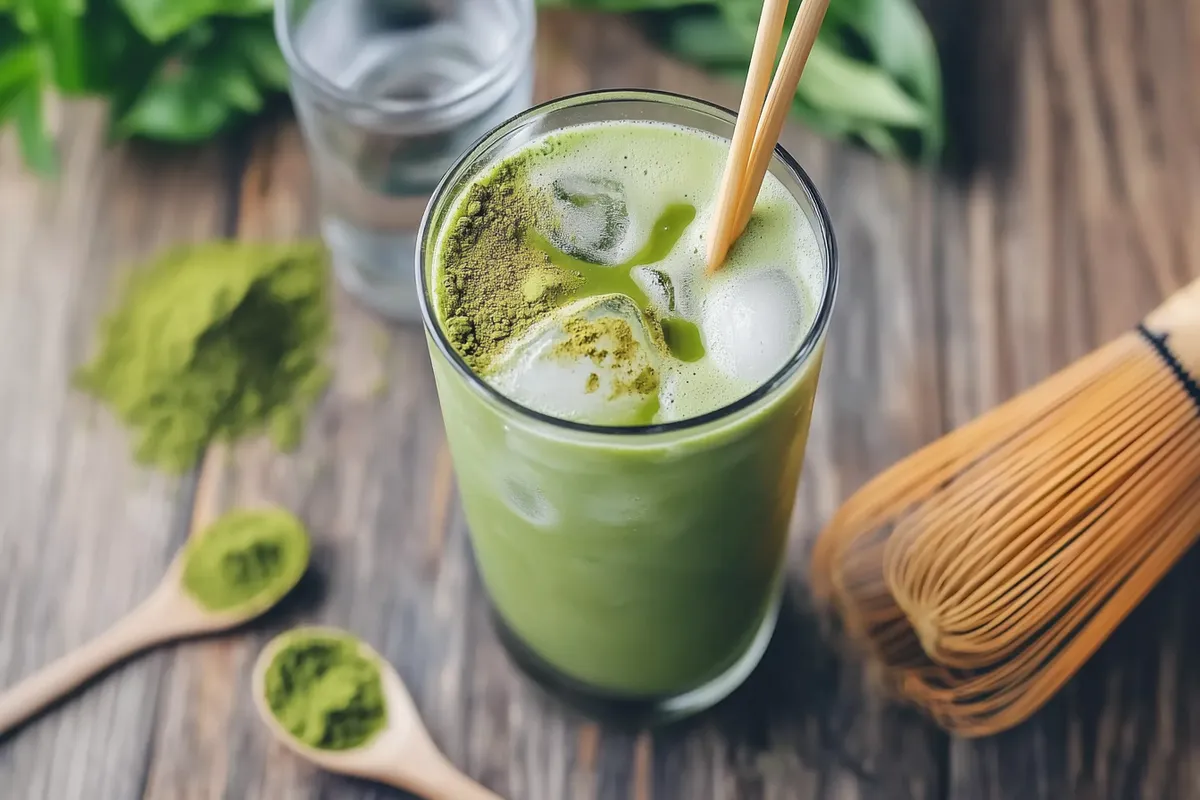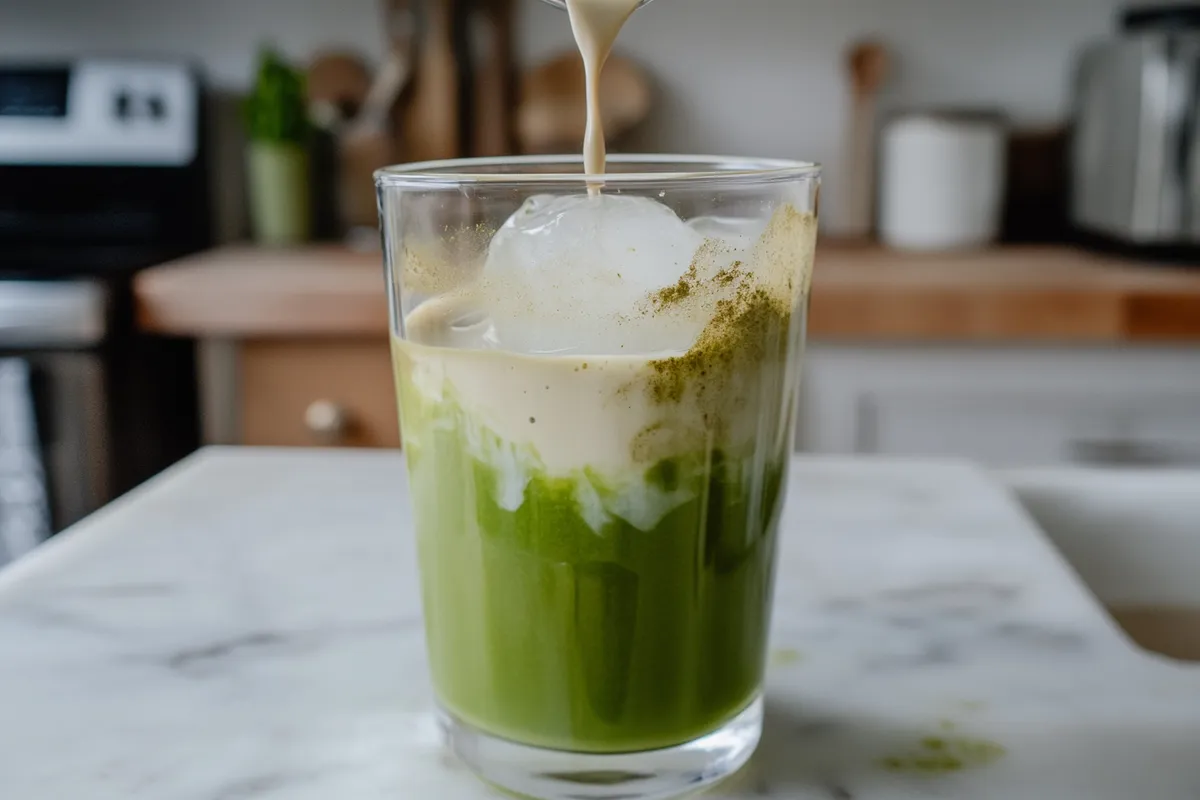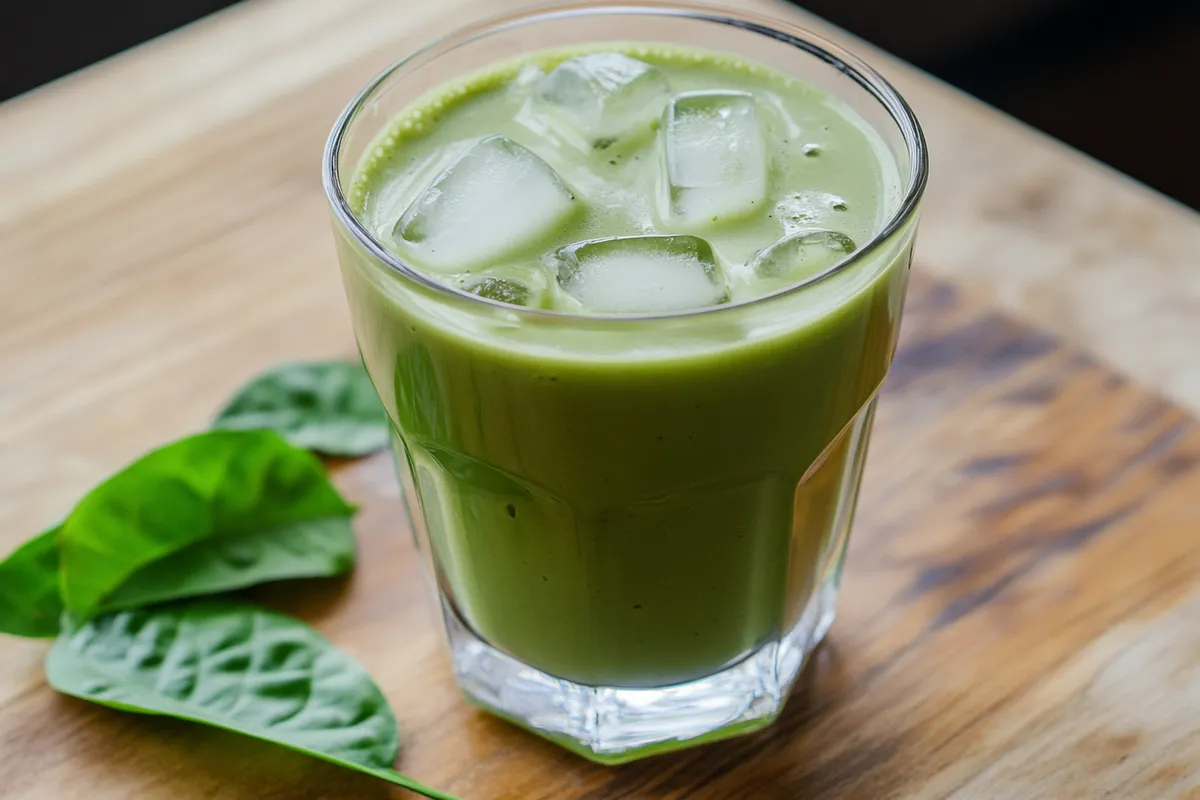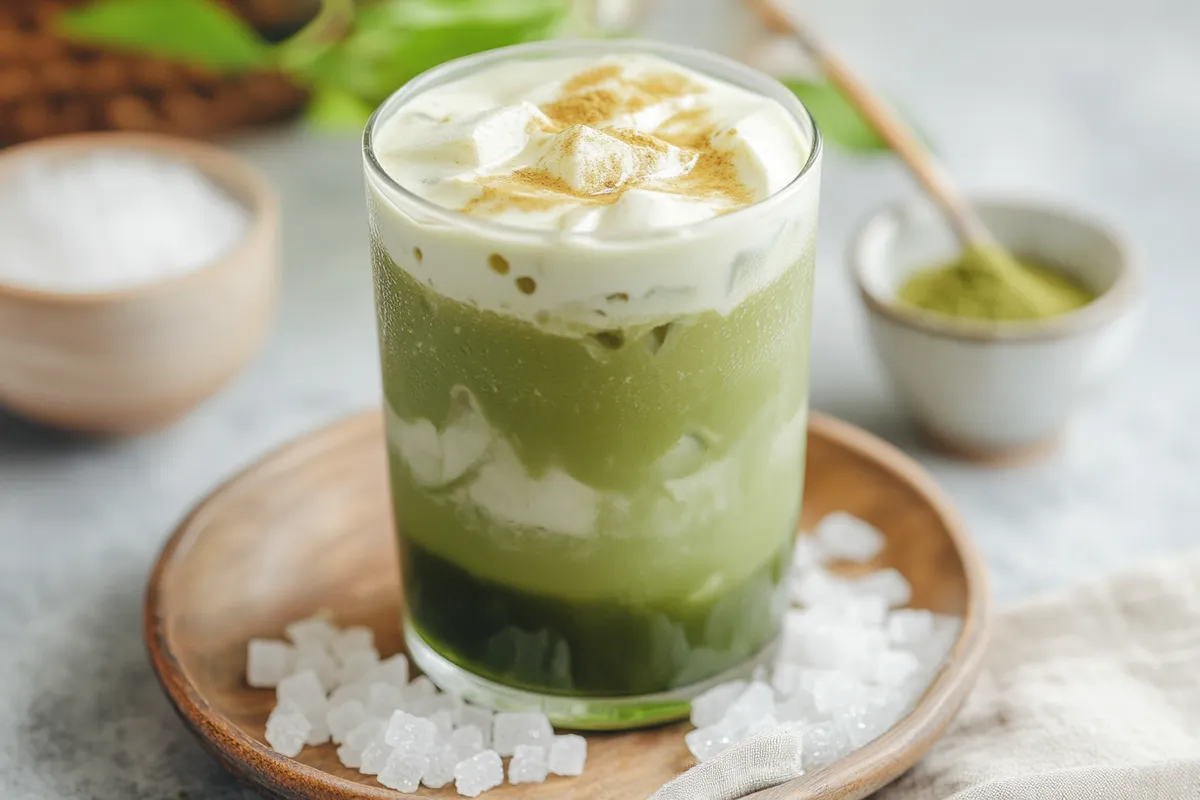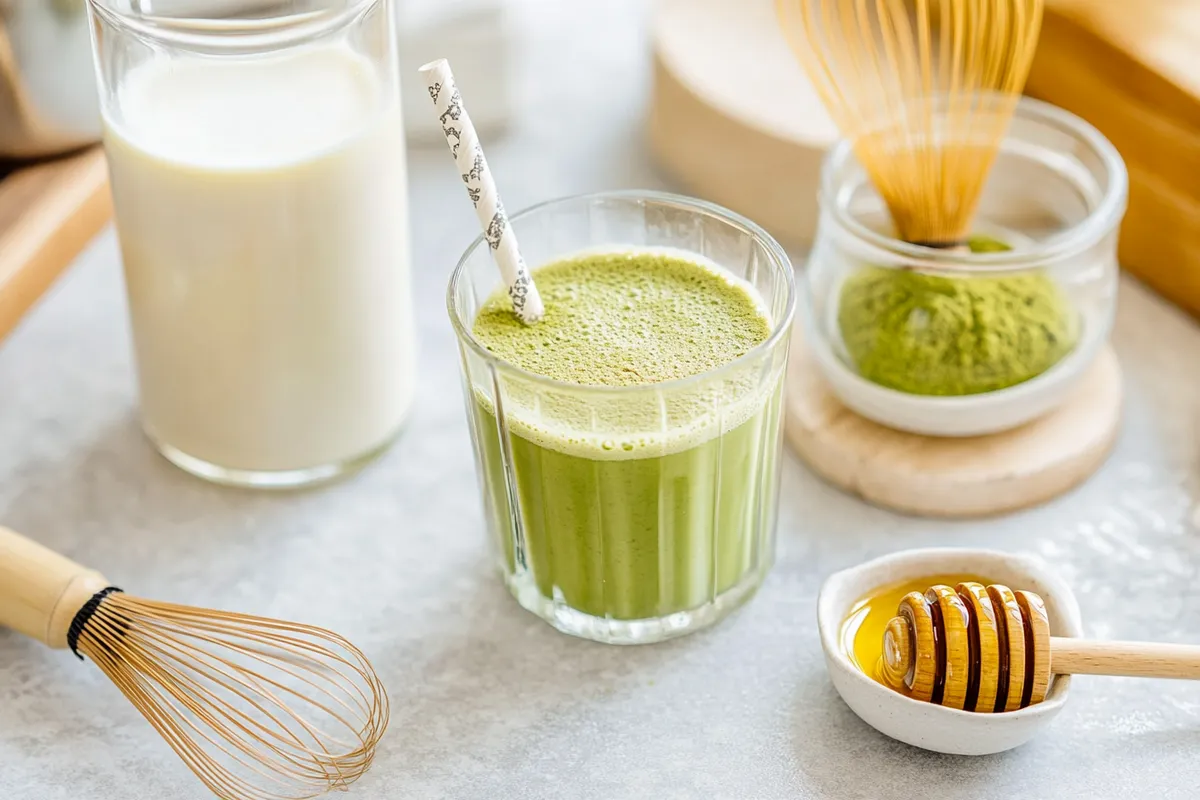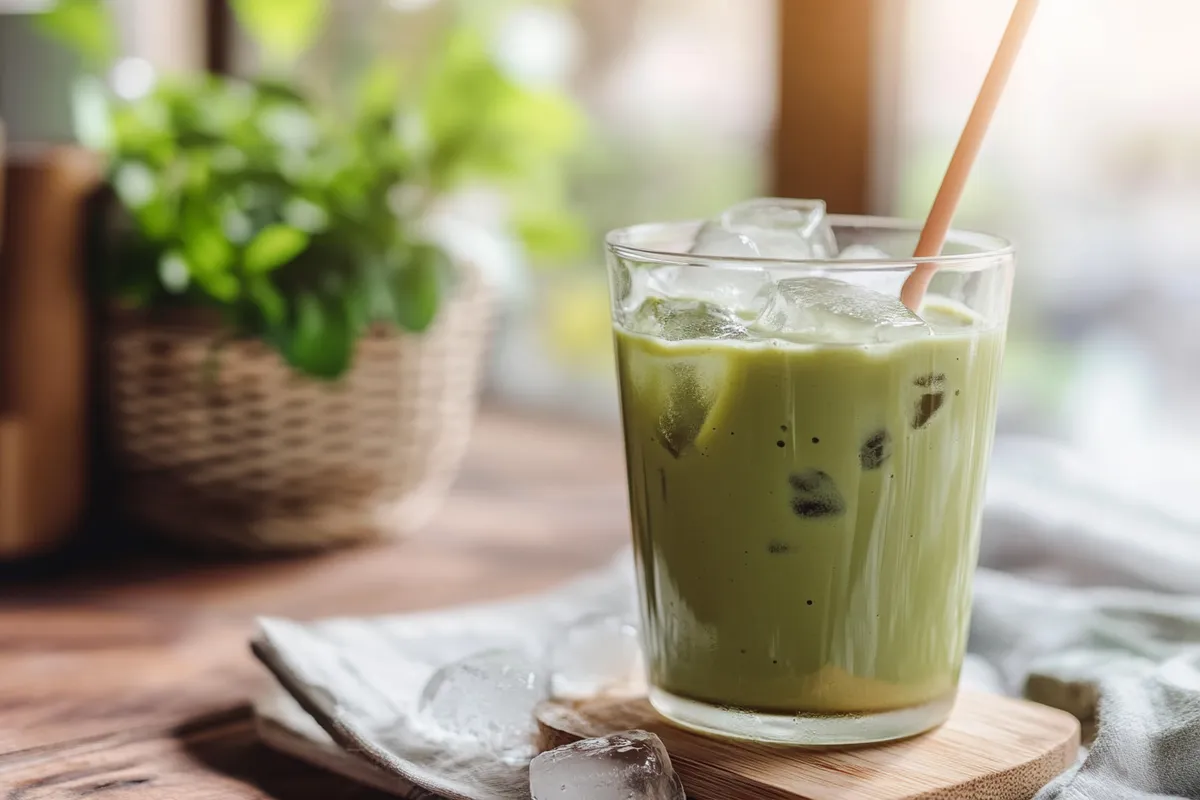Introduction
Is the Iced Matcha Latte Healthy? With its vibrant green color and rising popularity, the iced matcha latte has become a staple in cafes and on social media. But is it actually a healthy choice, or just another sugary trend? The answer isn’t simple, but it’s definitely worth exploring. In this article, we’ll dive into the health benefits of iced matcha lattes, potential drawbacks, and how to make them a healthier option for everyday enjoyment.
Matcha is known for its antioxidant-rich properties and metabolism-boosting benefits, but the way it’s prepared—especially when mixed with milk, ice, and sweeteners—can greatly affect its nutritional value. Let’s break down what makes this frothy drink so popular and whether it fits into a healthy lifestyle.
What is an Iced Matcha Latte?
Before diving into the health benefits and downsides, let’s understand what an iced matcha latte is. This drink combines matcha powder, milk (dairy or plant-based), ice, and sometimes sweeteners. You can customize it, but the core recipe blends matcha and milk over ice. The result is a smooth, green, and refreshing beverage.
Matcha is powdered green tea leaves. It contains chlorophyll, amino acids, and catechins, which are strong antioxidants. The matcha powder gives iced lattes their bold, earthy flavor. Many people prefer adding sweeteners, but ingredients can change its health benefits.
Nutritional Breakdown of an Iced Matcha Latte
When you take a sip of your iced matcha latte, it’s important to understand exactly what’s in it. Here’s the breakdown:
- Calories: A standard iced matcha latte can range from 100 to 300 calories, depending on whether you use sweeteners, types of milk, or extra toppings.
- Sugar: While matcha is naturally low in sugar, the sweeteners added to your latte—such as vanilla syrup or honey—can increase the sugar content. A traditional iced matcha latte from a cafe can contain anywhere from 10 to 40 grams of sugar, which may be a concern for those watching their sugar intake.
- Caffeine: As a green tea-based beverage, matcha provides a gentle caffeine boost. The caffeine content in a typical iced matcha latte is about 60-70 mg per serving, which is less than a regular coffee but more than a cup of green tea.
- Fat & Protein: Depending on whether you choose dairy or plant-based milk, your iced matcha latte can have varying amounts of fat and protein. For example, whole milk will contribute more fat, while almond or oat milk tends to be lower in both fat and calories.
What is an Iced Matcha Latte?
Understanding the Ingredients
At the core of any iced matcha latte is the matcha powder, a finely ground green tea powder that has been consumed for centuries in Japan. Unlike regular green tea, which is steeped and discarded, matcha involves consuming the entire powdered tea leaf, which is why it boasts a higher concentration of nutrients and antioxidants. The vibrant green color of the latte comes from the chlorophyll-rich matcha powder, making it a visually striking beverage.
The milk used in the latte can be either dairy or plant-based. Dairy milk adds a creamy texture, while plant-based options like almond, oat, or coconut milk offer a lighter alternative with their own distinct flavors. For example, oat milk complements the matcha’s earthy taste and adds a subtle sweetness without overwhelming it. The type of milk you choose impacts the calories and fat content of the drink, making it possible to tailor the latte to fit different dietary needs.
Next up, we have the ice and sweeteners. Ice is what transforms the matcha latte into a refreshing, chilled drink, perfect for hot weather. It also dilutes the drink slightly, making it less intense. Sweeteners, on the other hand, can turn a matcha latte into a dessert-like treat. Some cafes use flavored syrups, while others opt for more natural sweeteners like honey or agave. However, the amount of sweetener you add can drastically alter the drink’s sugar content, so it’s important to keep this in mind if you’re watching your sugar intake.
Nutritional Breakdown of iced matcha latte
Now let’s break down what’s in a typical iced matcha latte in terms of nutrition. The calorie count can vary significantly based on the type of milk and sweetener you choose. On average, a standard iced matcha latte with whole milk and a bit of sugar will clock in at around 150 to 250 calories. If you swap out dairy for something like almond milk, the calorie count can drop to as low as 100 calories, making it a more diet-friendly option.
The sugar content is where things can get tricky. A regular iced matcha latte can have anywhere from 10 to 40 grams of sugar, depending on the added sweeteners. If you want to lower the sugar content, you can always request less syrup or try a sugar-free version.
Aside from calories and sugar, your iced matcha latte contains some key nutrients. Matcha itself is packed with antioxidants, particularly catechins, which help protect your body from free radicals. It also provides a moderate amount of caffeine, which offers a smoother, longer-lasting energy boost compared to coffee. Lastly, fiber is present in matcha, though in smaller quantities, which contributes to digestive health.
Health Benefits of an Iced Matcha Latte
Rich in Antioxidants
One of the standout health benefits of iced matcha lattes is the rich supply of antioxidants. Matcha is loaded with catechins, a type of antioxidant that helps protect the body from oxidative stress caused by free radicals. These compounds play a crucial role in reducing inflammation and promoting overall cellular health. Compared to regular green tea, matcha contains significantly higher levels of these antioxidants because, unlike brewed green tea, the entire leaf is consumed.
When you compare matcha to other popular beverages like coffee or traditional green tea, the antioxidant profile is notably superior. While coffee does contain antioxidants, it lacks the potent catechins found in matcha, which are more effective at combating inflammation and protecting the body from harmful environmental factors. Green tea, while also rich in antioxidants, doesn’t provide the same concentrated levels that matcha does due to the difference in preparation methods. In essence, if you’re looking for a potent antioxidant boost, an iced matcha latte is an excellent choice.
Boosts Metabolism and Burns Fat
Matcha’s catechins, particularly epigallocatechin gallate (EGCG), are known to have a significant impact on your metabolism. Studies have shown that these compounds can increase fat oxidation and improve the efficiency of your body’s fat-burning processes. In other words, matcha helps your body burn fat more effectively, making it a popular addition to many weight-loss plans.
The boosted metabolism from matcha isn’t just about burning fat during exercise. Even at rest, your body may burn calories more efficiently. This makes the iced matcha latte a potential ally for those looking to shed a few pounds or maintain a healthy weight. The drink’s metabolism-boosting properties are not as intense as those of some weight loss supplements, but it’s a healthier and more sustainable approach.
Mental Clarity and Focus
Matcha’s caffeine content is different from what you’d find in your regular coffee. While coffee typically delivers a jolt of energy followed by a crash, matcha offers a smoother, more sustained release of caffeine. This is because matcha contains L-theanine, an amino acid that promotes relaxation and counterbalances the jitteriness often associated with caffeine. As a result, you get a calm, alert focus rather than the rapid spike and subsequent drop that many experience with coffee.
The combination of caffeine and L-theanine enhances cognitive function, improving concentration, memory, and overall mental clarity. This makes the iced matcha latte an ideal choice for people who need focus for extended periods, such as students, professionals, or anyone looking for a productivity boost. The steady energy and focus provided by matcha can be a game-changer for anyone who has struggled with the crash that comes from coffee.
Supports Heart Health
Another impressive benefit of drinking iced matcha lattes is the potential to support heart health. Studies suggest that matcha can lower cholesterol levels and reduce the risk of heart disease. Specifically, the catechins in matcha help reduce LDL cholesterol (the “bad” cholesterol), which is a major contributor to the development of heart disease. Additionally, matcha has anti-inflammatory properties that can help reduce the risk of inflammation-related heart conditions.
Matcha’s ability to improve cardiovascular health doesn’t just stop at lowering cholesterol. Regular consumption of matcha may also promote better blood circulation and help regulate blood pressure. The overall benefits contribute to a healthier heart and circulatory system, which is another reason to consider incorporating iced matcha lattes into your daily routine.
Detoxification and Skin Health
Matcha is also known for its detoxifying properties. The high levels of chlorophyll in matcha help the body remove toxins, acting as a natural detox agent. Drinking an iced matcha latte could contribute to better overall health by helping flush out harmful substances that accumulate over time.
Matcha also provides benefits for your skin. Its antioxidants and anti-inflammatory properties can reduce acne, redness, and puffiness. The detoxifying nature of matcha may help clear up skin by eliminating toxins from within. Plus, its antibacterial properties can aid in healing and preventing blemishes. By incorporating an iced matcha latte into your routine, you could potentially enhance both your internal and external health.
Potential Drawbacks and Considerations of iced matcha latte
High Sugar Content
While an iced matcha latte can be a deliciously refreshing beverage, its sugar content can quickly add up, especially when prepared with sweeteners or syrups. Many cafes and commercial recipes call for flavored syrups, such as vanilla or caramel, which can significantly increase the drink’s sugar intake. A typical iced matcha latte can contain anywhere from 20 to 40 grams of sugar, depending on the size and how much sweetener is added. That’s quite a hefty amount, considering the daily recommended sugar intake for most adults is around 25-36 grams.
If you’re watching your sugar consumption, there are ways to enjoy your iced matcha latte without overloading on sweetness. Opting for sugar-free syrups or simply cutting down on the amount of added sugar can make a big difference. For a more natural touch, you could sweeten your latte with honey, maple syrup, or stevia—each of these options offers a more balanced sugar profile. Alternatively, you could choose to skip the sweetener entirely, letting the natural flavor of matcha shine through. Adjusting the level of sweetness allows you to tailor your iced matcha latte to your personal health goals.
Caffeine Sensitivity
While the caffeine content in matcha is generally lower than coffee, it can still pose a concern for individuals who are sensitive to caffeine. A standard iced matcha latte typically contains around 60-70 mg of caffeine per serving, compared to the 95-150 mg found in an average cup of coffee. However, the way caffeine is released from matcha differs from coffee. The L-theanine in matcha works to slow down the absorption of caffeine, providing a more sustained, gentle boost of energy, rather than the quick jolt and subsequent crash often associated with coffee.
For some people, however, even this gentler release can be too much. If you’re someone who feels jittery or anxious with caffeine, you may need to reconsider the frequency of your iced matcha latte consumption. Additionally, if you enjoy the taste but want to avoid the caffeine, there are caffeine-free matcha alternatives, like barley tea or roasted brown rice tea, which mimic the flavor of matcha without the stimulating effects.
Dairy vs. Non-Dairy Milk
The type of milk you choose to pair with your iced matcha latte plays a significant role in both flavor and nutritional value. Dairy milk, with its creamy texture and rich flavor, is a classic choice. However, it’s also higher in calories and fat, especially if you opt for whole milk. For those watching their calorie intake, or following a plant-based diet, non-dairy milk alternatives like almond, oat, or soy milk provide an excellent option.
Almond milk is low in calories and fats, but some brands may add extra sugars or preservatives. Oat milk is creamier and tends to have a naturally sweeter taste, but it also has more carbohydrates, which may not be suitable for those on low-carb or keto diets. Soy milk, on the other hand, is high in protein, but some individuals may find it too rich in flavor. Each type of plant-based milk comes with its pros and cons—while non-dairy milk alternatives are often lower in calories, they can sometimes lack the nutritional balance found in dairy milk, like the calcium and vitamin D content.
In the end, your choice of milk will depend on your specific dietary needs, whether you’re concerned about calories, fat, or protein. The non-dairy milk options can help you customize your iced matcha latte to fit your lifestyle while still keeping it light and healthy.
Additives and Preservatives in Pre-made Lattes
It’s easy to grab a ready-made iced matcha latte from a cafe or convenience store when you’re on the go. However, these pre-made lattes can often come with hidden drawbacks. Many store-bought iced matcha lattes contain additives and preservatives, which can impact their overall healthiness. Ingredients like artificial sweeteners, flavor enhancers, and stabilizers may make the drink taste sweeter or last longer on the shelf, but they can also pose risks if consumed in large quantities.
Some additives, such as artificial flavorings or preservatives, can negatively affect your health over time, especially if you’re consuming them frequently. If you’re concerned about these hidden ingredients, consider making your own iced matcha latte at home using fresh, whole ingredients. By doing so, you can avoid unnecessary additives and keep your drink as natural and nutritious as possible.
How to Make a Healthier Iced Matcha Latte at Home
Choosing High-Quality Matcha
The first step in creating a healthier iced matcha latte is selecting the right matcha. Not all matcha is created equal, and choosing a premium, organic matcha powder can make a significant difference in both flavor and health benefits. Look for matcha that is labeled as ceremonial grade—this indicates the highest quality, typically made from young, tender leaves, which are ground into a fine powder. Ceremonial-grade matcha has a smoother, less bitter flavor, making it perfect for lattes.
Avoid culinary-grade matcha, which is cheaper and has a more astringent taste, as it’s often intended for cooking rather than drinking. When choosing matcha, check for vibrant, bright green powder; a duller color can be a sign of oxidation or poor quality. Additionally, choose organic matcha to avoid pesticide residues, ensuring that your matcha is as pure and healthy as possible.
Healthy Alternatives for Sweeteners
Sweeteners can make or break your iced matcha latte, but they can also add unwanted sugar and calories. To keep your latte healthy, opt for natural sweeteners like honey, stevia, or monk fruit. Honey is a great option as it provides natural sweetness and a slight floral flavor without overpowering the matcha’s taste. Just be sure to use it in moderation to avoid adding too many calories.
Stevia, a plant-based sweetener, is another excellent choice for those looking to cut out sugar altogether. It’s calorie-free and much sweeter than sugar, so you only need a small amount to sweeten your drink. Monk fruit sweetener is also gaining popularity due to its natural sweetness and zero-calorie content, without the aftertaste that some people associate with stevia.
For those looking to reduce sugar without sacrificing taste, start by experimenting with less sweeteners. Often, matcha has enough natural flavor that you can get by with a much lower sugar content than you’d expect. It’s all about finding the right balance that suits your taste buds while keeping the drink healthy.
Using Plant-Based Milk
The milk you choose for your iced matcha latte can make it healthier. If you avoid dairy or prefer lighter options, try plant-based milk. Almond milk is a favorite for its low calories and fat. However, it’s less creamy than dairy milk.
Oat milk offers a creamy texture that matches well with matcha’s earthy taste. It’s slightly sweeter but has more carbs than almond milk. Coconut milk adds a tropical flavor and richness without the calories of full-fat dairy milk. It is higher in fat but feels indulgent.
Each milk has different levels of calories, fat, and protein. Choose one that suits your diet. Watch for added sugars in some non-dairy milk and pick unsweetened versions whenever possible.
DIY Recipe for a Healthy Iced Matcha Latte
Making a healthy iced matcha latte at home is easy, and it allows you to control every ingredient for a more nutritious result. Here’s a simple step-by-step guide to preparing your own latte:
-
Ingredients:
- 1 teaspoon of high-quality matcha powder (ceremonial grade)
- 1/2 cup hot water (not boiling)
- 1 cup unsweetened plant-based milk (almond, oat, or coconut)
- Natural sweetener (optional—try honey, stevia, or monk fruit)
- Ice cubes
-
Instructions:
- Whisk the matcha: In a small bowl, sift the matcha powder to remove any clumps. Add hot water (around 175°F) and whisk vigorously using a bamboo whisk or a regular whisk until the matcha is fully dissolved and frothy.
- Sweeten: Add your desired sweetener, starting with a small amount. Stir until fully dissolved.
- Prepare the milk: In a separate glass, add the plant-based milk and ice cubes. If you prefer your latte cold but not too diluted, you can use crushed ice for a more intense flavor.
- Combine: Pour the whisked matcha into the glass with milk and ice, and stir gently. Adjust sweetness or milk quantity based on your preference.
-
Customize:
Feel free to modify this recipe to suit dietary preferences. For a low-sugar option, skip the sweetener or use stevia. If you’re following a vegan or keto diet, choose unsweetened almond milk and a sugar-free sweetener.
By preparing your own iced matcha latte at home, you can enjoy the delicious flavors without any of the excess sugars or additives found in pre-made versions. Plus, you can experiment with different variations to create a latte that perfectly fits your lifestyle and health goals.
FAQs about iced matcha latte
How many calories are in an iced matcha latte?
The calorie content of an iced matcha latte depends on the ingredients used. A standard iced matcha latte with whole milk and sweeteners can contain around 150 to 250 calories. Opting for non-dairy milk like almond or oat milk and reducing the sweetener can bring the calorie count down to about 100 to 150.
Is iced matcha latte high in caffeine?
An iced matcha latte has less caffeine than a regular cup of coffee. Typically, it contains 60-70 mg of caffeine per serving, compared to the 95-150 mg found in a standard coffee. The caffeine in matcha is released more slowly, providing a more sustained energy boost without the crash.
Can I make an iced matcha latte without sugar?
Yes, you can make an iced matcha latte without sugar. If you prefer a sweeter flavor, you can use natural sweeteners like stevia, monk fruit, or a small amount of honey, or simply enjoy the natural taste of matcha without any added sweeteners.
Is iced matcha latte better than iced coffee?
Whether an iced matcha latte is “better” than iced coffee depends on your preferences and health goals. Matcha offers a smoother, more sustained caffeine boost with additional health benefits, such as antioxidants and metabolism-boosting catechins, while coffee can cause a quicker caffeine spike.
Can I use oat milk for iced matcha latte?
Yes, oat milk is an excellent choice for an iced matcha latte. It’s creamy and naturally sweet, making it a great complement to the earthy flavor of matcha, while also being a good dairy-free alternative.
Can I drink matcha latte for weight loss?
Matcha lattes can support weight loss due to their metabolism-boosting catechins. However, drinking matcha alone won’t lead to weight loss. It should be combined with a balanced diet and exercise for effective results.
Is drinking iced matcha good for you?
Yes, drinking iced matcha provides several health benefits, including antioxidants, improved metabolism, enhanced mental clarity, and support for heart health. When consumed in moderation and made with healthy ingredients, it can be a nutritious choice.
Is it OK to drink matcha latte every day?
Yes, it’s generally safe to drink a matcha latte every day. Matcha contains moderate levels of caffeine, and drinking one latte daily can provide health benefits like antioxidants and better focus without excessive caffeine intake. However, if you’re sensitive to caffeine, it’s important to adjust the quantity.
Conclusion: Is the Iced Matcha Latte Healthy?
In conclusion, iced matcha lattes offer a variety of health benefits when consumed in moderation. Packed with antioxidants, catechins, and L-theanine, they can boost metabolism, improve mental clarity, and support heart health. These benefits make it a great alternative to sugary drinks or regular coffee, providing a smoother, more sustained caffeine boost. Matcha’s detoxifying properties also make it a fantastic option for those looking to support their skin health and reduce inflammation.
However, it’s important to keep in mind the potential drawbacks, particularly the sugar content. Many commercial iced matcha lattes are loaded with sweeteners and syrups, which can negate some of the health benefits. Additionally, if you’re sensitive to caffeine, you may need to monitor your intake.
An iced matcha latte can be a tasty and healthy drink. High-quality matcha, the right sweeteners, and plant-based milk make it special. It offers energy-boosting benefits and works well as a refreshing treat. Enjoy it as part of a balanced lifestyle. However, remember to choose your ingredients carefully and drink it in moderation. This way, your iced matcha latte becomes a guilt-free indulgence.

